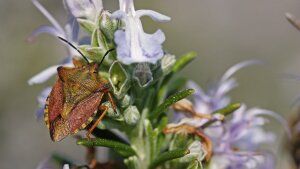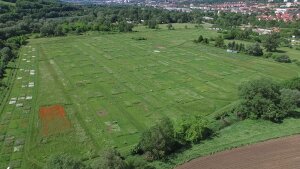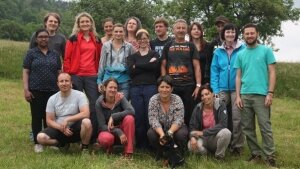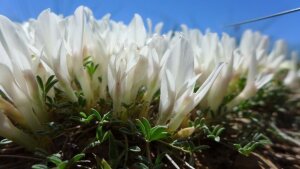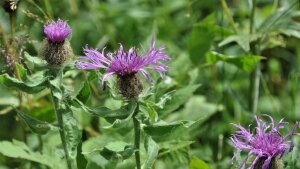Recent news
March: The 5th international SQuID workshop (statistical quantification of individual differences) is taking place in Sapporo, Japan.
March: Our annual Bachelor practical Evolutionary Biology is running in the first two weeks of March. We use simulation tools to teach students basic concepts of population genetics in a highly interactive way. As every year, it is great fun.
February: We have begun to plan this years MEES Master de student excursion to southern Spain. The excursion will focus on animal migration, birds in particular.
January: It seems we have made a big step towards understanding the genetic basis of the green-brown polymorphism in Chorthippus grasshoppers. Replicated differential expression analysis was produced robust results.
January: Anne and Max are attending an sDiv workshopExternal link sCONSUME. It is an international workshop that brings together early-career scientistcs from different disciplines. A great experience.
January: Elio and Benjamin have joined our group as two sDivExternal link funded postdocs. Elio will work on karyotype, genome size and sperm diversity of grasshoppers. And Benjamin will use variance decomposition approaches to model the role of species turnover on herbivore biomass. Welcome, Elio! Welcome, Benjamin
-
Research
Learn moreSting Bug (Antheminia varicornis)
Image: Holger SchielzethOur group covers three main lines of research, all united by the interest in understanding population-level biodiversity and its consequences for intra- und inter-species population dynamics. (i) trophic interactions and community dynamisc are the focus of Community Population Ecology line of research. (ii) Local adaptation, temporal population dynamics and behavioural ecology are the focus of Evolutionary Population Ecology line of resaerch. (iii) And the genomic architecture of genetic polymorphisms, speciation and hybridization are the focus of Molecular Population Ecology line of resarch. Furthermore, we are interested in (iv) ecological, evolutionary and startistical methods and therefore also cover the field that we call Population Ecology Methods.
-
Projects
Learn moreJena Experiment aerial photograph
Image: Jena-ExperimentContemporary scientific work is often very collaborative. We are therefore involved in several large collaborative research project. This includes the long-running Jena ExperimentExternal link that was established in 2002 and has been DFG-funded since then. More recently, we got engaged in a NC3 Collaborative Research CenterExternal link that is also funded by the DFG and studies the evolutionary ecology of individualized niches. Furthermore, we are participating in the German Centre for Integrative Biodiversity Research (iDiv)External link in Halle-Jena-Leipzig, the Michael Stifel Center Jena (MSCJ)External link for Data-Driven & Simulation Science and the Interantional Max Planck Research School (IMPRS)External link run by Max Planck Institute for Chemical Ecology in Jena. Additionally, we are involved in more grass-roots projects such as the Nutrient Network (NutNet)External link and the team for the Statistical Quantification of Individual Differences (SQuID). And finally, there are always ongoing individually funded projects that are also important.
-
Team
Learn morePopulation Ecology Group 2016
Image: Holger SchielzethWe are a team of currently six postdoctal researchers, three PhD students, five technical assistants, and four gardeners. We will occasionally solicit applications for funded PhD student positions. Furthermore, if you are interested in joining the group with external funding or as part of your studies, you may contact us at popecol@uni-jena.de.
-
Teaching
Learn moreFieldwork with students
Image: Günter KöhlerWe offer a variety of classes for the BSc level in Biology and the MSc level in Ecology, Evolution and Systematics. The topics range from introduction to faunistic field methods, evolutionary, community and conservation ecology, via population genetics to scientific writing and presentations. We also continously offer a selection of topics for Bachelor or Master projects. The list of ongoing and completed projects gives an impression about the range of topcis that we offer. Please to not hesitate to contact us if you are interested and movitated to work in the field of evolutiony, molecular or community ecology.
-
Recent publications
Learn moreWildermuth, B., Bröcher, M., Ladouceur, E., Meyer, S.T., Schielzeth, H., Staab, M., Achury, R., Blüthgen, N., Hertzog, L., Hines, J., Roscher, C., Schweiger, O., Weisser, W.W. & Ebeling, A. (2025). Arthropod species loss underpins biomass declines. Nature Ecology & Evolution doi: 10.1038/s41559-025-02909-yExternal link
Réale, D., Allegue, H., Araya-Ajoy , Y., Dochtermann, N., Nakagawa, S., Pick, J., Schielzeth, H., Westneat, D. & Dingemanse, N. (2025). Avoiding misleading estimates of among-individual variance caused by non-random sampling of individuals in a changeable environment. Methods in Ecology and Evolution doi: 10.1111/2041-210x.70202External link
Nakagawa, S., Westneat, D.F., Mizuno, A., Araya Ajoy, Y.G., Class, B., Dingemanse, N.J., Dochtermann, N.A., Lagisz, M., Laskowski, K., Pick, J.L., Réale, D., Williams, C., Wright, J. & Schielzeth, H. (2025). Understanding different types of repeatability and intra-class correlation for an analysis of biological variation. Journal of the Royal Society Interface doi: 10.1098/rsif.2025.0545External link
Lutgen, D., Peona, V., Chase, M.A., Alaei Kakhki, N., Lammers, F., de Souza, S.G., Ducrest, A.-L., Burri, M., Andriopoulos, P., Lukhele, S.M., Moysi, M., Yohannes, E., Abbasov, A., Albayrak, T., Aliabadian, M., Auchli, N., Bontzorlos, V., Christoforou, I., Copete, J.L., Fulco, E., Garcia, J.T., Javakhishvili, Z., Kazazou, A., Lei, F., Liu, Y., Paposhvili, N., Patchett, R., Péter, Á., Ritter, R., Sándor, A.D., Schneider, F., Shurulinkov, P., Sklyarenko, S., Stumberger, B., Tagiyev, A., Uboldi, A., Vogiatzis, N., Taborsak-Lines, F., Gruselius, J., Yao, L., Peichel, C.L., Suh, A., Gagnaire, P.-A., Kirschel, A.N.G., Schweizer, M., Schielzeth, H. & Burri, R. (2025). A mosaic of modular variation at a single gene underpins convergent plumage coloration. Science 390: eado8005. doi: 10.1126/science.ado8005External link
Bachmann, D., Buchmann, N., Ebeling, A. & Roscher, C. (2025). Traits of the leaf economics spectrum do not always relate to species biomass proportions in grassland communities of varying diversity. Ecology and Evolution 15: e72013. doi: 10.1002/ece3.72013External link
Kempel, A., Adamidis, G.C., Anadon, J.D., Atkinson, J., Auge, H., Avtzis, D., Bachelot, B., Bashirzadeh, M., Bota, J.L., Classen, A., Constantinou, I., Crawley, M., de Bellis, T., Dostal, P., Ebeling, A., Eisenhauer, N., Eldridge, D.J., Encina, G., Estrada, C., Everingham, S., Fanin, N., Feng, Y., Gaspar, M., Gooriah, L., Graff, P., Montalvan, E.G., Montalvan, P.G., Hartke, T.R., Huang, L., Jochum, M., Kaljund, K., Karmiris, I., Koorem, K., Korell, L., Laine, A.L., le Provost, G., Lessard, J.P., Liu, M., Liu, X., Liu, Y., Llancabure, J., Loiez, S., Loydi, A., Marrero, H., Gockel, S., Montoya, A., Munzbergova, Z., Niu, Y., Ott, D., Oyarzabal, M., Panitsa, M., Papatheodorou, E., Piper, F.I., Pussa, K., Rand, K., Saiz, H., Sanders, N.J., Schadler, M., Scherber, C., Semchenko, M., Sepp, S.K., Shah, M.A., Shaheen, I., Stein, C., Stewart, J., Tang, Z., Tschan, G., van Nouhuys, S., Vandegehuchte, M.L., Vernon, M., V, R.S., Wang, J., Xiao, Y., Xystrakis, F., Yang, J., Yang, S., Zografou, K. & Allan, E. (2025). The Bug-Network (BugNet): A global experimental network testing the effects of invertebrate herbivores and fungal pathogens on plant communities and ecosystem function in open ecosystems. Ecology and Evolution 15: e72111. doi: 10.1002/ece3.72111External link
Jiang, C., Varma, M., Shah, A., Palacios-Gimenez, O.M. & Schielzeth, H. (2025). Replicated differential expression analysis in a green-brown polymorphic grasshopper reveals role of beta-carotene-binding protein in body coloration. Molecular Ecology doi: 10.1111/mec.70142External link
Palacios-Gimenez, O.M., Varma, M., Cheng, X., Mosbech, M.-B., Suh, A. & Schielzeth, H. (2025). Chromosome-level assembly of the club-legged grasshopper (Gomphocerus sibiricus) genome. G3 - Genes Genomes Genetics doi: 10.1093/g3journal/jkaf231External link
Ivimey-Cook, E.R., Sanchez-Tojar, A., Berberi, I., Culina, A., Roche, D.G., R, A.A., Amin, B., Bairos-Novak, K.R., Balti, H., Bertram, M.G., Bliard, L., Byrne, I., Chan, Y.C., Cioffi, W.R., Corbel, Q., Elsy, A.D., Florko, K.R.N., Gould, E., Grainger, M.J., Harshbarger, A.E., Hovstad, K.A., Martin, J.M., Martinig, A.R., Masoero, G., Moodie, I.R., Moreau, D., O'Dea, R.E., Paquet, M., Pick, J.L., Rizvi, T., Silva, I., Szabo, B., Takola, E., Thore, E.S.J., Verberk, W., Windecker, S.M., Winter, G., Zajkova, Z., Zeiss, R. & Moran, N.P. (2025). From policy to practice: progress towards data- and code-sharing in ecology and evolution. Proceedings of the Royal Society B 292: 20251394. doi: 10.1098/rspb.2025.1394External link
Cabon, L., Varma, M., Winter, G., Ebeling, A. & Schielzeth, H. (2025). Phenotypic plasticity, heritability, and genotype-by-environment interactions in an insect dispersal polymorphism. BMC Ecology & Evolution doi: 10.1186/s12862-025-02447-yExternal link
Jiang, C., Roscher, C., Broecher, M., Ebeling, A., Wolf, J.B.W. & Schielzeth, H. (2025). Context-dependent relationships between genomic traits and plant performance in temperate grasslands. Functional Ecology doi: 10.1111/1365-2435.70133External link
Neumeister, D.S., González-Ramírez, D., Gaugel, S., Yazıcı, T.D., Haug, J., Schielzeth, H., Bailey, R. & Pereira, R.J. (2025). Clarifying diversity in the radiation of Chorthippus grasshoppers (Orthoptera: Acrididae) through an integration of genomic and morphometric approaches. Zoological Journal of the Linnean Society doi: 10.1093/zoolinnean/zlaf076External link
Jiang, C., Huang, Z., Meizoso, C., Kumpfmüller, G., Wolf, J.B.W. & Schielzeth, H. (2025). Full-length transcriptomes of 25 grassland plant species. Scientific Data 12: 922. doi: 10.1038/s41597-025-05280-6External link
Albuquerque, L., Milani, D., Martí, E., Ferretti, A.B.S.M., Rico-Porras, J.M., Mora, P., Lorite, P., Ziabari, O.S., Brisson, J.A., Palacios-Gimenez, O.M. & Cabral-de-Mello, D.C. (2025). Exploring the Satellitome of the Pest Aphid Acyrthosiphon pisum (Hemiptera, Aphididae): Insights Into Genome Organization and Intraspecies Evolution. Genome Biology and Evolution 17: evaf104. doi: 10.1093/gbe/evaf104External link
Zhang, P.F., Seabloom, E.W., Foo, J., MacDougall, A.S., Harpole, W.S., Adler, P.B., Hautier, Y., Eisenhauer, N., Spohn, M., Bakker, J.D., Lekberg, Y., Young, A.L., Carbutt, C., Risch, A.C., Peri, P.L., Smith, N.G., Stevens, C.J., Prober, S.M., Knops, J.M.H., Wardle, G.M., Dickman, C.R., Ebeling, A., Roscher, C., Martinson, H.M., Martina, J.P., Power, S.A., Niu, Y.J., Ren, Z.W., Du, G.Z., Virtanen, R., Tognetti, P., Tedder, M.J., Jentsch, A., Catford, J.A. & Borer, E.T. (2025). Dominant species predict plant richness and biomass in global grasslands. Nature Ecology & Evolution 9: 924-936. doi: 10.1038/s41559-025-02701-yExternal link
Durán-Fuentes, J.A., Maronna, M.M., Palacios-Gimenez, O.M., Castillo, E.R., Ryan, J.F., Daly, M. & Stampar, S.N. (2025). Repeatome diversity in sea anemone genomics (Cnidaria: Actiniaria) based on the Actiniaria-REPlib library. BMC Genomics 26: 473. doi: 10.1186/s12864-025-11591-0External link
Mundinger, C., Schulz, N.K.E., Singh, P., Janz, S., Schurig, M., Seidemann, J., Kurtz, J., Müller, C., Schielzeth, H., von Kortzfleisch, V.T. & Richter, S.H. (2025). Three species, three labs, three experiments: testing the reproducibility of ecological studies on insect behaviour in a multi-laboratory setting. PLoS Biology 23: e3003019. doi: 10.1371/journal.pbio.3003019External link
Halliday, F.W., Everingham, S.E., Bröcher, M., Ebeling, A., Kempel, A., Mundim, F.M., Strauss, A.T., Xirocostas, Z.A. & Kohli, M. (2025). Towards an integrative mechanistic framework for biodiversity-consumer relationships. Trends in Ecology & Evolution doi: 10.1016/j.tree.2025.03.005External link
Bröcher, M., Meyer, S.T., Leher, A.G. & Ebeling, A. (2025). Ecological traits for 1374 arthropod species collected in a German grassland. Ecology 106: e70077. doi: 10.1002/ecy.70077External link
Virtanen, R., Borer, E.T., Crawley, M., Ebeling, A., Harpole, W.S., Risch, A.C., Roscher, C., Schütz, M., Seabloom, E.W. & Eskelinen, A. (2025). Neglecting non-vascular plants leads to underestimation of grassland plant diversity loss under experimental nutrient addition. Journal of Ecology doi: 10.1111/1365-2745.70052External link
Varma, M., Winter, G., Ebeling, A., Lehmann, A., Cabon, L., Palacios-Gimenez, O.M., Pratap, N. & Schielzeth, H. (2025). Few genetic loci control the green-brown color polymorphism in the meadow grasshopper Pseudochorthippus parallelus. Journal of Evolutionary Biology doi: 10.1093/jeb/voaf036 doi: 10.1093/jeb/voaf036External link
Winter, G. & Schielzeth, H. (2025). Genetic and habitat complexity effects on unpredictability in escape behavior of a grasshopper species. Journal of Evolutionary Biology doi: 10.1093/jeb/voaf030External link
Nelson, R.A., Sullivan, L.L., Hersch-Green, E.I., Seabloom, E.W., Borer, E.T., Tognetti, P.M., Adler, P.B., Biederman, L., Bugalho, M.N., Caldeira, M.C., Cancela, J.P., Carvalheiro, L.G., Catford, J.A., Dickman, C.R., Dolezal, A.J., Donohue, I., Ebeling, A., Eisenhauer, N., Elgersma, K.J., Eskelinen, A., Estrada, C., Garbowski, M., Graff, P., Gruner, D.S., Hagenah, N., Haider, S., Harpole, W.S., Hautier, Y., Jentsch, A., Johanson, N., Koerner, S.E., Lannes, L.S., MacDougall, A.S., Martinson, H., Morgan, J.W., Olde Venterink, H., Orr, D., Osborne, B.B., Peri, P.L., Power, S.A., Raynaud, X., Risch, A.C., Shrestha, M., Smith, N.G., Stevens, C.J., Veen, G.F.C., Virtanen, R., Wardle, G.M., Wolf, A.A., Young, A.L. & Harrison, S.P. (2025). Forb diversity globally is harmed by nutrient enrichment but can be rescued by large mammalian herbivory. Communications Biology 8: 444. doi: 10.1038/s42003-025-07882-7External link
McCune, K.B., Williams, C., Dochtermann, N.A., Schielzeth, H. & Nakagawa, S. (2025). Repeatability and intra-class correlations from time-to-event data: towards a standardized approach. Animal Behaviour doi: 10.1016/j.anbehav.2025.123102External link
Bonato Asato, A.E., Guimarães‐Steinicke, C., Stein, G., Schreck, B., Kattenborn, T., Ebeling, A., Posch, S., Denzler, J., Büchner, T., Shadaydeh, M., Wirth, C., Eisenhauer, N. & Hines, J. (2025). Seasonal shifts in plant diversity effects on above‐ground–below‐ground phenological synchrony. Journal of Ecology doi: 10.1111/1365-2745.14470External link
Bonato Asato, A.E., Ebeling, A., Wirth, C., Eisenhauer, N. & Hines, J. (2025). Positive plant diversity effects on soil detritivore feeding activity and stability increase with ecosystem age. Soil Biology and Biochemistry 200: 109637. doi: 10.1016/j.soilbio.2024.109637External link
Institute of Ecology and Evolution
The Population Ecology Group is one of the four research groups in the Institute of Ecology and Evolution de (est. 2018). The joint interest of the institute representing evolutionary processes and functional biodiversity analyses in teaching and research at the FSU. The other three groups in the institute are the Biodiversity of Plants Group (Prof. Römermann) de, the Systematic Botany Group (Prof. Hellwig) de and the Ecology Group (Prof. Halle) de.
Dornburger Str. 159
07743 Jena
Google Maps site planExternal link
